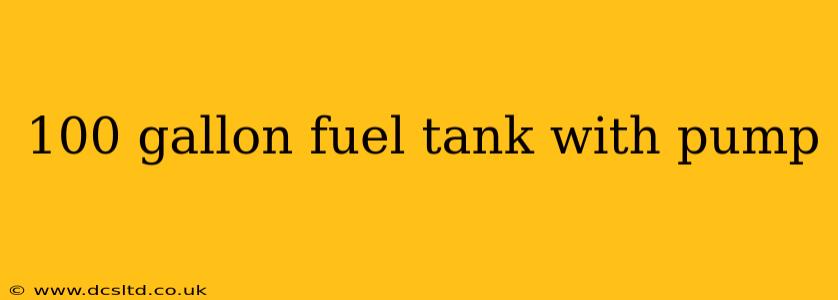Finding the right 100-gallon fuel tank with a pump can be challenging, given the variety of options available for different applications. This guide explores the key considerations to help you choose the best system for your specific needs, whether it's for a farm, construction site, or off-grid property. We'll also address some frequently asked questions to provide a comprehensive overview of this essential equipment.
What are the different types of 100-gallon fuel tanks?
100-gallon fuel tanks come in various materials, each with its own pros and cons:
-
Steel: Steel tanks are durable and robust, offering excellent resistance to damage. However, they are susceptible to rust and corrosion, requiring regular maintenance and potentially shorter lifespans compared to other materials if not properly protected.
-
Polyethylene (Plastic): Polyethylene tanks are lightweight, corrosion-resistant, and often more affordable than steel. They are less susceptible to damage from punctures but can be more prone to cracking under extreme temperature fluctuations or significant impacts.
-
Fiberglass: Fiberglass tanks offer a good balance between durability and corrosion resistance. They are relatively lightweight and strong but can be more expensive than polyethylene tanks.
The choice of material often depends on the intended use and environmental conditions.
What types of pumps are available for 100-gallon fuel tanks?
The pump selection is equally crucial. Several pump types are compatible with 100-gallon fuel tanks:
-
Hand Pumps: These are the most basic and inexpensive option, ideal for infrequent use and low-volume dispensing. They require manual operation and are less efficient for large-scale fuel transfer.
-
Electric Pumps: Electric pumps offer convenience and efficiency, particularly for larger fuel transfers. They require a power source but are significantly faster and less labor-intensive than hand pumps. These pumps can be further categorized by flow rate (gallons per minute, or GPM) and the type of motor (12V, 110V, etc.).
-
Rotary Vane Pumps: These are a common choice for fuel transfer, known for their relatively high flow rates and the ability to handle thicker fluids.
What are the safety features to consider?
Safety should be paramount when choosing a 100-gallon fuel tank and pump system. Look for tanks and pumps with the following:
-
Overfill Prevention: This critical feature prevents spills and potential hazards associated with overfilling the tank.
-
Spill Containment: A secondary containment system, such as a sump or a double-walled tank, is highly recommended to prevent fuel spills in the event of a leak.
-
Grounding: Proper grounding helps prevent static electricity buildup, a significant fire hazard when dealing with flammable liquids.
-
Flame Arresters: For certain applications, flame arresters are necessary to prevent ignition of fuel vapors.
How much does a 100-gallon fuel tank with a pump cost?
The price varies significantly based on the tank material, pump type, and included features. Expect to pay anywhere from a few hundred dollars for a basic steel tank with a hand pump to several thousand dollars for a high-capacity system with an electric pump and advanced safety features.
What are the applications for a 100-gallon fuel tank with a pump?
100-gallon fuel tanks with pumps find use in a wide variety of settings:
-
Agriculture: Fueling tractors, combines, and other farm equipment.
-
Construction: Providing fuel for heavy machinery and equipment on construction sites.
-
Off-Grid Living: Storing and dispensing fuel for generators, vehicles, and other equipment in remote locations.
-
Emergency Preparedness: Maintaining a readily available fuel supply in case of power outages or other emergencies.
-
Landscaping: Fueling lawnmowers, weed eaters, and other landscaping equipment.
How do I choose the right size pump for my needs?
The appropriate pump size depends on your fuel consumption rate. Consider the volume of fuel you'll need to transfer and the time you have available. Higher GPM pumps are faster but typically more expensive. A slower pump might suffice if you don't need to fill equipment quickly.
How do I maintain a 100-gallon fuel tank and pump?
Regular maintenance is essential to ensure the longevity and safety of your fuel tank and pump system. This includes:
-
Regular Inspections: Check for leaks, corrosion, and damage.
-
Cleanliness: Keep the tank and surrounding area clean to prevent contamination.
-
Pump Maintenance: Follow the manufacturer's instructions for pump maintenance and lubrication.
-
Proper Storage: If not in continuous use, store the tank properly to prevent damage and contamination.
By carefully considering these factors, you can select the optimal 100-gallon fuel tank with a pump system for your specific needs and ensure safe and efficient fuel management. Remember to consult local regulations and safety guidelines when handling and storing fuel.
